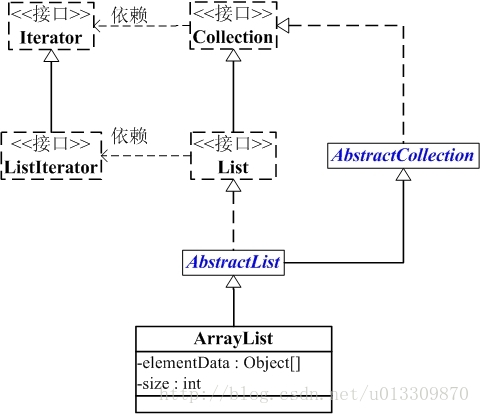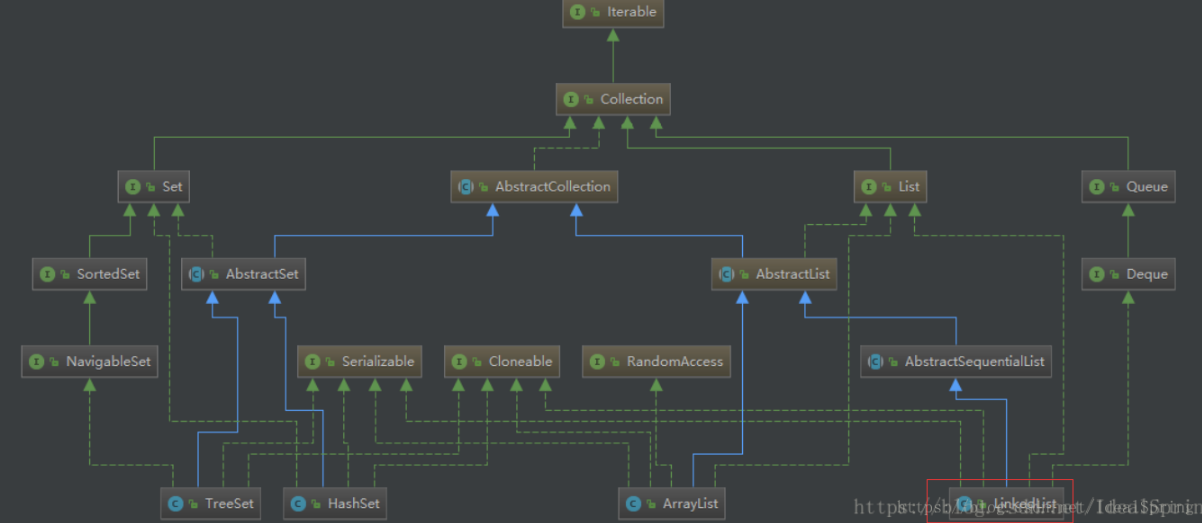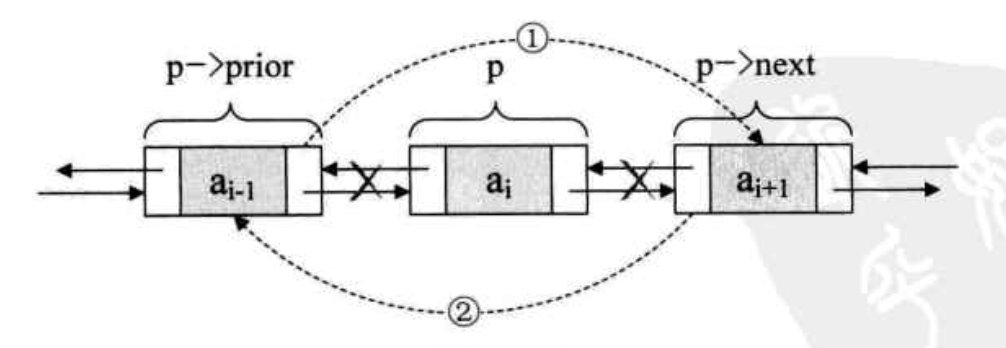List集合源码解读
一:总述:
主要讲解3个集合
1.ArrayList:
底层是数组,线程不安全;
2.LinkedList:
底层是链表,线程不安全;
3.Vector
底层数据结构是数组。线程安全;
二:ArrayList解析

首先,我们来看一下ArrayList的属性:
/**
* Default initial capacity.
*/
private static final int DEFAULT_CAPACITY = 10;//初始化容量值
- /**
- * Shared empty array instance used for empty instances.
- */
- private static final Object[] EMPTY_ELEMENTDATA = {};//指定ArrayList的容量为0时,返回该空数组
- /**
- * Shared empty array instance used for default sized empty instances. We
- * distinguish this from EMPTY_ELEMENTDATA to know how much to inflate when
- * first element is added.
- */
- private static final Object[] DEFAULTCAPACITY_EMPTY_ELEMENTDATA = {};//与上个属性的区别是:该数组是默认返回的,而上个属性是指定容量为0时返回
- /**
- * The array buffer into which the elements of the ArrayList are stored.
- * The capacity of the ArrayList is the length of this array buffer. Any
- * empty ArrayList with elementData == DEFAULTCAPACITY_EMPTY_ELEMENTDATA
- * will be expanded to DEFAULT_CAPACITY when the first element is added.
- */
- transient Object[] elementData; // non-private to simplify nested class access//第一次保存元素时,数组将会扩容
- /**
- * The size of the ArrayList (the number of elements it contains).
- *
- * @serial
- */
- private int size;//ArrayList的实际大小
根据上面我们可以清晰的发现:ArrayList底层其实就是一个数组,ArrayList中有扩容这么一个概念,正因为它扩容,所以它能够实现“动态”增长
2.2构造方法
- /**
- * Constructs an empty list with the specified initial capacity.
- *
- * @param initialCapacity the initial capacity of the list
- * @throws IllegalArgumentException if the specified initial capacity
- * is negative
- */
//指定初始化长度initCapacity- public ArrayList(int initialCapacity) {
- if (initialCapacity > 0) {
- this.elementData = new Object[initialCapacity];
- } else if (initialCapacity == 0) {
- this.elementData = EMPTY_ELEMENTDATA;
- } else {
- throw new IllegalArgumentException("Illegal Capacity: "+
- initialCapacity);
- }
- }
- /**
- * Constructs an empty list with an initial capacity of ten.
- */
//否则返回的是:DEFAULTCAPACITY_EMPTY_ELEMENTDATA- public ArrayList() {
- this.elementData = DEFAULTCAPACITY_EMPTY_ELEMENTDATA;
- }
- /**
- * Constructs a list containing the elements of the specified
- * collection, in the order they are returned by the collection's
- * iterator.
- *
- * @param c the collection whose elements are to be placed into this list
- * @throws NullPointerException if the specified collection is null
- */
- public ArrayList(Collection<? extends E> c) {
- elementData = c.toArray();
- if ((size = elementData.length) != 0) {
- // c.toArray might (incorrectly) not return Object[] (see 6260652)
- if (elementData.getClass() != Object[].class)
- elementData = Arrays.copyOf(elementData, size, Object[].class);
- } else {
- // replace with empty array.
- this.elementData = EMPTY_ELEMENTDATA;
- }
- }
2.3 Add()方法
源码如下:
- /**
- * Appends the specified element to the end of this list.
- *
- * @param e element to be appended to this list
- * @return <tt>true</tt> (as specified by {@link Collection#add})
- */
- public boolean add(E e) {
- ensureCapacityInternal(size + 1); // Increments modCount!!
- elementData[size++] = e;
- return true;
- }
- /**
- * Inserts the specified element at the specified position in this
- * list. Shifts the element currently at that position (if any) and
- * any subsequent elements to the right (adds one to their indices).
- *
- * @param index index at which the specified element is to be inserted
- * @param element element to be inserted
- * @throws IndexOutOfBoundsException {@inheritDoc}
- */
- public void add(int index, E element) {
- rangeCheckForAdd(index);
- ensureCapacityInternal(size + 1); // Increments modCount!!
- System.arraycopy(elementData, index, elementData, index + 1,
- size - index);
- elementData[index] = element;
- size++;
- }
2.3.1 Add(E e)
步骤:
- 检查是否需要扩容
- 插入元素
首先,我们来看看这个方法:
- public boolean add(E e) {
- ensureCapacityInternal(size + 1); // Increments modCount!!
- elementData[size++] = e;
- return true;
- }
该方法很短,我们可以根据方法名就猜到他是干了什么:
- 确认list容量,尝试容量加1,看看有无必要
- 添加元素
接下来我们来看看这个小容量(+1)是否满足我们的需求:
- private void ensureCapacityInternal(int minCapacity) {
//想要得到的最小的容量- if (elementData == DEFAULTCAPACITY_EMPTY_ELEMENTDATA) {
- minCapacity = Math.max(DEFAULT_CAPACITY, minCapacity);
- }
- //确定明确的容量
- ensureExplicitCapacity(minCapacity);
- }
- private void ensureExplicitCapacity(int minCapacity) {
- modCount++;
- //如果最小容量比数组长度大,则用用grow扩容
- // overflow-conscious code
- if (minCapacity - elementData.length > )
- grow(minCapacity);
- }
接下来看grow是如何扩容的
- /**
- * Increases the capacity to ensure that it can hold at least the
- * number of elements specified by the minimum capacity argument.
- *
- * @param minCapacity the desired minimum capacity
- */
- private void grow(int minCapacity) {
- // overflow-conscious code
- int oldCapacity = elementData.length;
- int newCapacity = oldCapacity + (oldCapacity >> 1);//扩容1.5倍
- if (newCapacity - minCapacity < 0)
- newCapacity = minCapacity;
- if (newCapacity - MAX_ARRAY_SIZE > 0)
- newCapacity = hugeCapacity(minCapacity);
- // minCapacity is usually close to size, so this is a win:
- elementData = Arrays.copyOf(elementData, newCapacity);//扩容完后调用copyOf方法把原数组的值存入新数组
- }
再来看是怎么把原数组的值放入新数组
- /**
- * Copies the specified array, truncating or padding with nulls (if necessary)
- * so the copy has the specified length. For all indices that are
- * valid in both the original array and the copy, the two arrays will
- * contain identical values. For any indices that are valid in the
- * copy but not the original, the copy will contain <tt>null</tt>.
- * Such indices will exist if and only if the specified length
- * is greater than that of the original array.
- * The resulting array is of the class <tt>newType</tt>.
- *
- * @param <U> the class of the objects in the original array
- * @param <T> the class of the objects in the returned array
- * @param original the array to be copied
- * @param newLength the length of the copy to be returned
- * @param newType the class of the copy to be returned
- * @return a copy of the original array, truncated or padded with nulls
- * to obtain the specified length
- * @throws NegativeArraySizeException if <tt>newLength</tt> is negative
- * @throws NullPointerException if <tt>original</tt> is null
- * @throws ArrayStoreException if an element copied from
- * <tt>original</tt> is not of a runtime type that can be stored in
- * an array of class <tt>newType</tt>
- * @since 1.6
- */
- public static <T,U> T[] copyOf(U[] original, int newLength, Class<? extends T[]> newType) {
- @SuppressWarnings("unchecked")
- T[] copy = ((Object)newType == (Object)Object[].class)
- ? (T[]) new Object[newLength]
- : (T[]) Array.newInstance(newType.getComponentType(), newLength);
- System.arraycopy(original, 0, copy, 0,
- Math.min(original.length, newLength));
- return copy;
- }
到目前为止,我们就可以知道add(E e)的基本实现了:
- 首先去检查一下数组的容量是否足够
- 足够:直接添加
- 不足够:扩容
- 扩容到原来的1.5倍
- 第一次扩容后,如果容量还是小于minCapacity,就将容量扩充为minCapacity。
2.3.2:add(int index, E element)
步骤:
- 检查角标
- 空间检查,如果有需要进行扩容
- 插入元素
我们来看看插入的实现:
- /**
- * Inserts the specified element at the specified position in this
- * list. Shifts the element currently at that position (if any) and
- * any subsequent elements to the right (adds one to their indices).
- *
- * @param index index at which the specified element is to be inserted
- * @param element element to be inserted
- * @throws IndexOutOfBoundsException {@inheritDoc}
- */
- public void add(int index, E element) {
- rangeCheckForAdd(index);//检查是否越界
- ensureCapacityInternal(size + 1); // Increments modCount!!//扩容
- System.arraycopy(elementData, index, elementData, index + 1,
- size - index);//调用arraycopy进行插入
- elementData[index] = element;
- size++;
- }
注:arraycopy是用c++来编写的
2.4:get()
- 检查角标
- 返回元素
- /**
- * Returns the element at the specified position in this list.
- *
- * @param index index of the element to return
- * @return the element at the specified position in this list
- * @throws IndexOutOfBoundsException {@inheritDoc}
- */
- public E get(int index) {
- rangeCheck(index);
- return elementData(index);
- }
- // 检查角标
- private void rangeCheck(int index) {
- if (index >= size)
- throw new IndexOutOfBoundsException(outOfBoundsMsg(index));
- }
- // 返回元素
- E elementData(int index) {
- return (E) elementData[index];
- }
2.5:set()方法
步骤:
- 检查角标
- 替代元素
- 返回旧值
- /**
- * Replaces the element at the specified position in this list with
- * the specified element.
- *
- * @param index index of the element to replace
- * @param element element to be stored at the specified position
- * @return the element previously at the specified position
- * @throws IndexOutOfBoundsException {@inheritDoc}
- */
- public E set(int index, E element) {
- rangeCheck(index);
- //将值进行替代,返回旧值
- E oldValue = elementData(index);
- elementData[index] = element;
- return oldValue;
- }
2.6:remove()方法
步骤:
- 检查角标
- 删除元素
- 计算出需要移动的个数,并移动
- 设置为null,让Gc回收
- /**
- * Removes the element at the specified position in this list.
- * Shifts any subsequent elements to the left (subtracts one from their
- * indices).
- *
- * @param index the index of the element to be removed
- * @return the element that was removed from the list
- * @throws IndexOutOfBoundsException {@inheritDoc}
- */
- public E remove(int index) {
- rangeCheck(index);
- modCount++;
- E oldValue = elementData(index);
//左移的个数- int numMoved = size - index - 1;
- if (numMoved > 0)
- System.arraycopy(elementData, index+1, elementData, index,
- numMoved);
- elementData[--size] = null; // clear to let GC do its work
- return oldValue;
- }
2.7:总述
- ArrayList是基于动态数组实现的,在增删时候,需要数组的拷贝复制(使用的是System.arrayCopy()效率最高的数组拷贝方法)。
- ArrayList的默认初始化容量是10,每次扩容时候增加原先容量的一半,也就是变为原来的1.5倍
- 删除元素时不会减少容量,若希望减少容量则调用trimToSize()
- 它不是线程安全的。它能存放null值。
三:Vector与ArrayList的区别
1.Vector底层也是数组,与ArrayList最大的区别就是:同步(线程安全),Vector的每个方法都是同步的 (相对效率较低)
2.在要求非同步的情况下,我们一般都是使用ArrayList来替代Vector的了,如果想要ArrayList实现同步,可以使用Collections的方法:List list =Collections.synchronizedList(new ArrayList(...));,就可以实现同步了
3.ArrayList是以1.5倍扩容,Vector是以2倍扩容
以上的结论可以在源码中得到验证
四:LinkedList解析
此处放一张全家桶

LinkedList底层是双向链表
- private static class Node<E> {
- E item;
- Node<E> next;
- Node<E> prev;
- Node(Node<E> prev, E element, Node<E> next) {
- this.item = element;
- this.next = next;
- this.prev = prev;
- }
- }
4.1:构造方法
- /**
- * Constructs an empty list.
- */
- public LinkedList() {
- }
- /**
- * Constructs a list containing the elements of the specified
- * collection, in the order they are returned by the collection's
- * iterator.
- *
- * @param c the collection whose elements are to be placed into this list
- * @throws NullPointerException if the specified collection is null
- */
- public LinkedList(Collection<? extends E> c) {
- this();
- addAll(c);
- }
4.2: add()方法
- public boolean add(E e) {
- linkLast(e);
- return true;
- }
- //往链表的最后添加元素
- void linkLast(E e) {
- final Node<E> l = last;
- final Node<E> newNode = new Node<>(l, e, null);
- last = newNode;
- if (l == null)
- first = newNode;
- else
- l.next = newNode;
- size++;
- modCount++;
- }
4.3:remove()方法
- /**
- * Removes the first occurrence of the specified element from this list,
- * if it is present. If this list does not contain the element, it is
- * unchanged. More formally, removes the element with the lowest index
- * {@code i} such that
- * <tt>(o==null ? get(i)==null : o.equals(get(i)))</tt>
- * (if such an element exists). Returns {@code true} if this list
- * contained the specified element (or equivalently, if this list
- * changed as a result of the call).
- *
- * @param o element to be removed from this list, if present
- * @return {@code true} if this list contained the specified element
- */
- public boolean remove(Object o) {
- if (o == null) {
- for (Node<E> x = first; x != null; x = x.next) {
- if (x.item == null) {
//删除元素- unlink(x);
- return true;
- }
- }
- } else {
- for (Node<E> x = first; x != null; x = x.next) {
//判断元素是否存在里面- if (o.equals(x.item)) {
- unlink(x);
- return true;
- }
- }
- }
- return false;
- }
- /**
- * Unlinks non-null node x.
- */
- E unlink(Node<E> x) {
- // assert x != null;
- final E element = x.item;
- final Node<E> next = x.next;
- final Node<E> prev = x.prev;
- if (prev == null) {
- first = next;
- } else {
- prev.next = next;
- x.prev = null;
- }
- if (next == null) {
- last = prev;
- } else {
- next.prev = prev;
- x.next = null;
- }
- x.item = null;
- size--;
- modCount++;
- return element;
- }

4.4:get()方法
- public E get(int index) {
- checkElementIndex(index);
- return node(index).item;
- }
node()方法
- /**
- * Returns the (non-null) Node at the specified element index.
- */
- Node<E> node(int index) {
- // assert isElementIndex(index);
- //下标小于长度的一半,从头部开始遍历
- if (index < (size >> 1)) {
- Node<E> x = first;
- for (int i = 0; i < index; i++)
- x = x.next;
- return x;
//否则从尾部开始遍历- } else {
- Node<E> x = last;
- for (int i = size - 1; i > index; i--)
- x = x.prev;
- return x;
- }
- }
4.5:set方法
set方法和get方法其实差不多,根据下标来判断是从头遍历还是从尾遍历
- public E set(int index, E element) {
- checkElementIndex(index);
- Node<E> x = node(index);
- E oldVal = x.item;
- x.item = element;
- return oldVal;
- }
具体请参考源码
五:总结
ArrayList:
- 底层实现是数组
- ArrayList的默认初始化容量是10,每次扩容时候增加原先容量的一半,也就是变为原来的1.5倍
- 在增删时候,需要数组的拷贝复制(C++实现)
LinkedList:
- 底层实现是双向链表[双向链表方便实现往前遍历]
Vector:
- 底层是数组,现在已少用,被ArrayList替代,原因有两个:
- Vector所有方法都是同步,有性能损失。
- Vector初始length是10 超过length时 以100%比率增长,相比于ArrayList更多消耗内存。
总的来说:查询多用ArrayList,增删多用LinkedList。
ArrayList增删慢不是绝对的(在数量大的情况下,已测试):
- 如果增加元素一直是使用
add()(增加到末尾)的话,那是ArrayList要快 - 一直删除末尾的元素也是ArrayList要快【不用复制移动位置】
- 至于如果删除的是中间的位置的话,还是ArrayList要快!
但一般来说:增删多还是用LinkedList,因为上面的情况是极端的~
List集合源码解读的更多相关文章
- 【Java集合】ArrayDeque源码解读
简介 双端队列是一种特殊的队列,它的两端都可以进出元素,故而得名双端队列. ArrayDeque是一种以循环数组方式实现的双端队列,它是非线程安全的. 它既可以作为队列也可以作为栈. 继承体系 Arr ...
- SDWebImage源码解读之SDWebImageCache(上)
第五篇 前言 本篇主要讲解图片缓存类的知识,虽然只涉及了图片方面的缓存的设计,但思想同样适用于别的方面的设计.在架构上来说,缓存算是存储设计的一部分.我们把各种不同的存储内容按照功能进行切割后,图片缓 ...
- AFNetworking 3.0 源码解读 总结(干货)(下)
承接上一篇AFNetworking 3.0 源码解读 总结(干货)(上) 21.网络服务类型NSURLRequestNetworkServiceType 示例代码: typedef NS_ENUM(N ...
- AFNetworking 3.0 源码解读 总结(干货)(上)
养成记笔记的习惯,对于一个软件工程师来说,我觉得很重要.记得在知乎上看到过一个问题,说是人类最大的缺点是什么?我个人觉得记忆算是一个缺点.它就像时间一样,会自己消散. 前言 终于写完了 AFNetwo ...
- AFNetworking 3.0 源码解读(一)之 AFNetworkReachabilityManager
做ios开发,AFNetworking 这个网络框架肯定都非常熟悉,也许我们平时只使用了它的部分功能,而且我们对它的实现原理并不是很清楚,就好像总是有一团迷雾在眼前一样. 接下来我们就非常详细的来读一 ...
- AFNetworking 3.0 源码解读(三)之 AFURLRequestSerialization
这篇就讲到了跟请求相关的类了 关于AFNetworking 3.0 源码解读 的文章篇幅都会很长,因为不仅仅要把代码进行详细的的解释,还会大概讲解和代码相关的知识点. 上半篇: URI编码的知识 关于 ...
- AFNetworking 3.0 源码解读(四)之 AFURLResponseSerialization
本篇是AFNetworking 3.0 源码解读的第四篇了. AFNetworking 3.0 源码解读(一)之 AFNetworkReachabilityManager AFNetworking 3 ...
- AFNetworking 3.0 源码解读(五)之 AFURLSessionManager
本篇是AFNetworking 3.0 源码解读的第五篇了. AFNetworking 3.0 源码解读(一)之 AFNetworkReachabilityManager AFNetworking 3 ...
- AFNetworking 3.0 源码解读 总结
终于写完了 AFNetworking 的源码解读.这一过程耗时数天.当我回过头又重头到尾的读了一篇,又有所收获.不禁让我想起了当初上学时的种种情景.我们应该对知识进行反复的记忆和理解.下边是我总结的 ...
随机推荐
- python连接数据库(1)——mysql
mysql是世界上应用最广的免费数据库,python当然也提供了对它的调用. 首先pip install pymysql,当然自己要知道数据库的用户名和密码,本地数据库的host就是localhost ...
- 【web自动化测试】requests-html 这个解析库,能让你更轻松的获取网页内容
1. 开始 Python 中可以进行网页解析的库有很多,常见的有 BeautifulSoup 和 lxml 等.在网上玩爬虫的文章通常都是介绍 BeautifulSoup 这个库,我平常也是常用这个库 ...
- iOS开发(4):录音AVAudioRecorder
录音,声音的采集,一般有两种实现办法,一是使用AVAudioRecorder,一是使用AudioUnit.如果只是简单的录音,使用AVAudioRecorder就可以了,如果想更灵活地处理刚录到的声音 ...
- 《周四橄榄球之夜》流媒体视频拆解:Twitch VS Amazon Prime
文 / Phil Cluff 译 / 王月美 原文链接:https://mux.com/blog/thursday-night-football-streaming-technology-showdo ...
- spring 5.x 系列第12篇 —— 整合memcached (代码配置方式)
文章目录 一.说明 1.1 XMemcached客户端说明 1.2 项目结构说明 1.3 依赖说明 二.spring 整合 memcached 2.1 单机配置 2.2 集群配置 2.3 存储基本类型 ...
- 在java项目启动时就执行某操作
在java启动时大概有四种,此处只介绍3种 1.在启动的方法上使用通过@PostConstruct方法实现初始化bean进行操作 2.通过bean实现InitializingBean接口 @Overr ...
- vscode解决同步设置插件连接不上git
vscode有一款比较好用的插件,就是设置同步.可以在一台电脑上同步另一台电脑的所有配置及插件! Settings Sync 但是在公司电脑有个奇葩问题,就是连接不上git. 解决:配置代理 &quo ...
- 网络学习笔记(三):HTTP缓存
HTTP缓存是一种保存资源副本并在下次请求时直接使用该副本的技术,合理的使用缓存可以有效的提升web性能. 浏览器将js文件.css文件.图片等资源缓存,当下次请求这些资源时,可以不发送网络请 ...
- java中方法的重载和覆盖
java中方法的重载和覆盖 先来了解一下这两个名词的含义. 重载: 在一个类当中才可以重载,方法名相同,参数个数不同或参数个数相同而参数类型不同. 覆盖: 又称重写,在派生类(子类)中重写基类(父类) ...
- ASP.NET Core on K8S学习初探(3)部署API到K8S
在上一篇<基本概念快速一览>中,我们把基本的一些概念快速地简单地不求甚解地过了一下,本篇开始我们会将ASP.NET Core WebAPI部署到K8S,从而结束初探的旅程. Section ...
